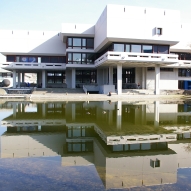| Dokumentenart: | Buchkapitel |
|---|---|
| ISBN: | 978-1-607-41702-6 |
| Buchtitel: | Handbook of Hydrogels |
| Verlag: | Nova Science Publ. |
| Ort der Veröffentlichung: | New York, NY |
| Seitenbereich: | S. 379-425 |
| Datum: | 2009 |
| Institutionen: | Chemie und Pharmazie > Institut für Physikalische und Theoretische Chemie > Lehrstuhl für Chemie IV - Physikalische Chemie (Solution Chemistry) > Prof. Dr. Werner Kunz |
| Stichwörter / Keywords: | review hydrogel spinal cord injury scaffold biocompatibility |
| Dewey-Dezimal-Klassifikation: | 500 Naturwissenschaften und Mathematik > 540 Chemie |
| Status: | Veröffentlicht |
| Begutachtet: | Ja, diese Version wurde begutachtet |
| An der Universität Regensburg entstanden: | Ja |
| Dokumenten-ID: | 24926 |
Zusammenfassung
A review. Spinal cord injury represents a devastating disease affecting primarily previously healthy young individuals leading in most instances to permanent and severe disability. Currently no sufficient regenerative therapeutic strategy exists for this disease. Following spinal cord injury spinal cord parenchyma including glial and neuronal cells is irreversibly lost. In particular after ...

Zusammenfassung
A review. Spinal cord injury represents a devastating disease affecting primarily previously healthy young individuals leading in most instances to permanent and severe disability. Currently no sufficient regenerative therapeutic strategy exists for this disease. Following spinal cord injury spinal cord parenchyma including glial and neuronal cells is irreversibly lost. In particular after complete spinal cord injury, which disrupts all descending motor and ascending sensory projections, functional recovery is only achievable by bridging the lesion defect to allow regrowth across the site of injury and reinnervation of previous target neurons. Substantial progress in this respect has been achieved through cell transplantation strategies. Specific primary cell populations replace lost spinal cord parenchyma and provide a growth permissive interface for regenerating axons. However, in all of these strategies axon regeneration does not occur in a directed fashion, preventing reconnecting of disrupted axon pathways. Therefore, the injured spinal cord requires a regrowth directing structured scaffold. Hydrogels are a promising candidate for such a scaffold, since depending on their compn. and mode of assembly they can not only replace the degenerated lesion area, but also elicit oriented axon regeneration by means of their anisotropic structure. Hydrogels are built up from hydrophilic natural or synthetic polymers that are phys. or chem. cross-linked forming a coherent three-dimensional network dispersed in a large amt. of water (up to 99%). Most hydrogels exhibit good biocompatibility and their mech. properties which are similar to those of many biol. tissues addnl. recommend them for biomedical applications. Subject of this review is to describe the various types, compn., stability and the three-dimensional structure of hydrogels, which are suitable to bridge spinal cord lesion defects as a prerequisite for functional recovery. Furthermore the capacity of various hydrogels alone or in combination with other regrowth promoting strategies (cell therapy, application of growth factors, neutralization of growth inhibitory mols.) to elicit nerve regeneration in in vitro and in vivo models of central nervous system axon injury and the relevance for a putative clin. application will be critically discussed.
Metadaten zuletzt geändert: 25 Mai 2018 10:38



 Weitere Literatur (mittels CORE)
Weitere Literatur (mittels CORE)